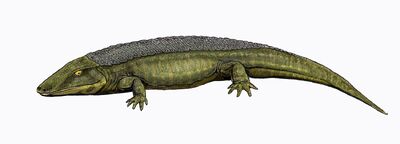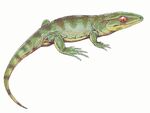
| Reptiliomorpha Fossil range: Early Carboniferous-Middle Triassic Descendant taxon Amniota survives to present | |
|---|---|
 Chroniosuchus, a reptiliomorph. | |
| Scientific classification
| |
|
Superclass |
|
|
Superorder |
Reptiliomorpha |
|
Major Sub-Groups |
|
Reptiliomorpha is a name given either to reptile-like labyrinthodonts, or to amniotes and the amphibians from which they evolved.
Characteristics[]
University of Bristol paleontologist Professor Michael J. Benton (2000, 2004) gives the following characteristics for the Reptiliomorpha:
- narrow premaxillae (less than half the skull width)
- vomers taper forward
- phalangeal formulae (number of joints in each toe) of foot 2.3.4.5.4-5
Evolutionary history[]
During the Carboniferous and Permian periods, tetrapods evolved along a number of parallel lines towards a reptilian condition. Some of these tetrapods (e.g. Archeria, Eogyrinus) were elongate, eel-like aquatic forms with diminutive limbs, while others (e.g. Seymouria, Solenodonsaurus, Diadectes, Limnoscelis) were so reptile-like that until quite recently they actually have been considered true reptiles, and it is likely that to an observer they would have appeared to a modern observer as small- to medium-size, heavy-set lizards.
The land-based reptilomorphs probably had water-tight skin, covered with horny scales in reptilian fashion, but retained aquatic eggs and larva (tadpoles). Thus they where reptilian in all but their reproductive biology. A drive to abandon the larval stage and aquatic eggs (possibly due to competition for breeding ponds or to exploit drier environments) led to internal fertilization and direct development (completing the tadpole stage within the egg). A striking parallel can be seen in the frog family Leptodactylidae, which has a very diverse reproductive system, including foam nests, non-feeding terrestrial tadpoles and direct development.
True terrestrial life was achieved with the development of the amniote egg, where a number of membranous sacks protect the embryo. The first to evolve was probably the allantois, a sack that develops from the the gut/yolk-sack. This sack contains the embryo's nitrogenous waste (urea) during development, stopping it from poisoning the embryo. A very small allantois is found in modern amphibians. Later came the amnion surrounding the fetus proper, and the chorion, encompassing the amnion, allantois, and yolk-sack.
Exactly where the border between reptile-like amphibians and amniotes goes will probably never be known, as the reproductive structures involved fossilize poorly, but various advanced, small reptilomorphs have been suggested as the first true amniotes, including Casineria and Westlothiana.
Although the first amniote probably appeared as early as the latest Mississippian period (Middle Carboniferous), reptilomorph tetrapods continued to flourish alongside their fully reptilian descendants and relatives for many millions of years. By the middle Permian the non-amniote terrestrial forms had died out, but several aquatic groups continued to the end of the Permain, and in the case of the Chroniosuchids survived the end Permian mass extinction, only to die out at the end of the Early Triassic. Meanwhile, the single most successful daughter-clade of the Reptiliomorphs, the Amniotes, continued to flourish and to inherit the Earth.
Changing Definitions[]
The name Reptiliomorpha was coined by Professor Gunnar Säve-Söderbergh in 1934 to designate various types of late Paleozoic reptile-like labyrinthodont "amphibians."
However Alfred Sherwood Romer used the name Anthracosauria instead, and this has been used until quite recently e.g. Carroll 1988.
In 1956 Friedrich von Huene included both amphibians and anapsid reptiles in the Reptiliomorpha. This included the following orders: 1. Anthracosauria, 2. Seymouriamorpha, 3. Microsauria, 4. Diadectomorpha, 5. Procolophonia, 6. Pareiasauria, 7. Captorhinidia, 8. Testudinata.
In 1997 Michel Laurin and Robert Reisz (1997) adapted the term in a cladistic sense. Michael Benton (2000, 2004) made it the sister-clade to Batrachomorpha. However, when considered a linnean ranking, Reptiliomorpha is given the rank of superorder and only includes reptile-like tetrapods [Systema Naturae 2000]. More recently Reptiliomorpha has been adopted as the term for the largest clade that includes - according to the technical definitions of the phylocode which only refers to species or genus level organisms - Homo sapiens but not Ascaphus truei (a primitive frog) (International Phylogenetic Nomenclature Meeting 2003). Or, as Toby White (Palaeos website) puts it, more like dogs than frogs (i.e. mammals but not amphibians).
Taxonomy[]
Classification after Benton (1997):


Gefyrostegus.


- Superclass Tetrapoda
- Superorder Reptiliomorpha
- Family Caerorhachidae
- Family Tokosauridae
- Order Chroniosuchia
- Family Chroniosuchidae
- Order Embolomeri
- Family Eoherpetontidae
- Family Anthracosauridae
- Family Proterogyrinidae
- Family Eogyrinidae
- Family Archeriidae
- Order Seymouriamorpha
- Family Kotlassiidae
- Family Discosauriscidae
- Family Seymouriidae
- (unranked) Cotylosauria
- Order Diadectomorpha
- Family Limnoscelidae
- Family Diadectidae
- Series Amniota
- Order Diadectomorpha
- Superorder Reptiliomorpha
References and External links[]
- Benton, M. J. (2000), Vertebrate Paleontology, 2nd Ed. Blackwell Science Ltd 3rd ed. 2004 - see also taxonomic hierarchy of the vertebrates, according to Benton 2004
- Carroll, R. L., 1988: Vertebrate paleontology and evolution. W. H. Freeman and company, New York
- Laurin, M. & Reisz, R. R., (1997): A new perspective on tetrapod phylogeny. 9-59 in Sumida, S. S. & Martin, K. L. M., 1997: Amniote origins: Completing the trasition to Land Academic Press, San Diego
- Marjanovic, David, (2002) Re: thoughts on which nodes to name Dinosaur Mailing List
- Mikko's PhylogenyReptiliomorpha - after Laurin & Reisz, 1997;after Paton, Smithson, & Clack, 1999
- Palaeos Reptilomorpha
- Säve-Söderbergh, G. (1934). Some points of view concerning the evolution of the vertebrates and the classification of this group. Arkiv för Zoologi, 26A, 1-20.
- Second circular of the first International Phylogenetic Nomenclature Meeting 2003
- Systema Naturae 2000 / Classification Superorder Reptiliomorpha
- Von Huene, F., 1956, Paläontologie und Phylogenie der niederen Tetrapoden, G. Fischer, Jena.